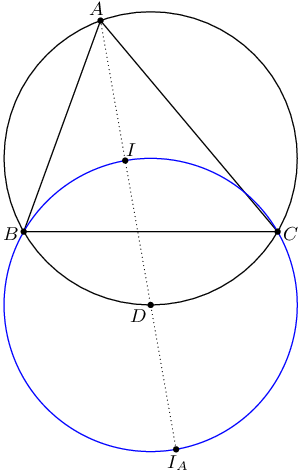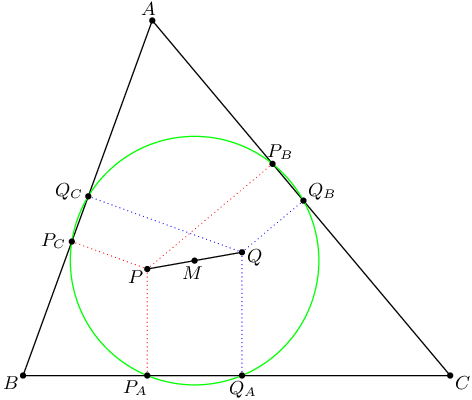In this post I’ll cover three properties of isogonal conjugates which were only recently made known to me. These properties are generalization of some well-known lemmas, such as the incenter/excenter lemma and the nine-point circle.
1. Definitions
Let be a triangle with incenter
, and let
be any point in the interior of
. Then we obtain three lines
,
,
. Then the reflections of these lines across lines
,
,
always concur at a point
which is called the isogonal conjugate of
. (The proof of this concurrence follows from readily from Trig Ceva.) When
lies inside
, then
is the point for which
and so on.
The isogonal conjugate of is sometimes denoted
. Note that
.
Examples of pairs of isogonal conjugates include the following.
- The incenter is its own isogonal conjugate. Similarly, each excenter is also its own isogonal conjugate.
- The isogonal conjugate of the circumcenter is the orthocenter.
- The isogonal conjugate of the centroid is the symmedian point.
- The isogonal conjugate of the Nagel point is the point of concurrence of
,
,
, where
is the contact point of the
–mixtilinear incircle. The proof of this result was essentially given as Problem 5 of the European Girl’s Math Olympiad.
2. Inverses and Circumcircles
You may already be aware of the famous result (which I always affectionately call “Fact 5”) that the circumcenter of is the midpoint of arc
of the circumcircle of
. Indeed, so is the circumcenter of triangle
, where
is the
-excenter.
In fact, it turns out that we can generalize this result for arbitrary isogonal conjugates as follows.
Theorem 1 Let
and
be isogonal conjugates. Then the circumcenters of
and
are inverses with respect to the circumcircle of
.
Proof: This is just angle chasing. Let and
be the desired circumcenters. It’s clear that both
and
lie on the perpendicular bisector of
. Angle chasing allows us to compute that
Similarly, . But the reader can check that
. Using this we can show that
, so
, as needed.
When we take and
to be
(or
), we recover the Fact 5 we mentioned above. When we take
to be the orthocenter and
to be the circumcenter, we find that the circumcenter of
is the inverse of the circumcenter of
. But the inverse of the circumcenter of
is the reflection of
over
. Thus we derive that
and
have circumcircles which are just reflections over
.
3. Pedal Circles
You may already be aware of the nine-point circle, which passes through the midpoints and feet of the altitudes of . In fact, we can obtain such a circle for any pair of isogonal conjugates.
Theorem 2 Let
and
be isogonal conjugates in the interior of
. The pedal triangles of
and
share a circumcircle. Moreover, the center of this circle is the midpoint
of
.
Upon taking and
we recover the nine-point circle. Of course, the incircle is the special case
!
Proof: Let and
be the pedal triangles. We leave the reader to check that
Consequently, the points ,
,
,
are concyclic. The circumcenter of these four points is the intersection of the perpendicular bisectors of segments
and
, which is precisely
. Thus
Similarly work with the other vertices shows that is indeed the desired circumcenter.
There is a second way to phrase this theorem by taking a homothety at .
Corollary If the point
is reflected about the sides
,
, and
, then the resulting triangle has circumcenter
.
4. Ellipses
We can actually derive the following remarkable result from the above theorem.
Theorem 3 An ellipse
is inscribed in triangle
. Then the foci
and
are isogonal conjugates.
Of course, the incircle is just the special case when the ellipse is a circle.
Proof: We will deduce this from the corollary. Let the ellipse be tangent at points ,
,
. Moreover, let the reflection of
about the sides of
be points
,
,
. By definition, there is a common sum
with
Because of the tangency condition, the points ,
,
are collinear. But now
and we deduce
So is the circumcenter of
. Hence
is the isogonal conjugate of
.
The converse of this theorem is also true; given isogonal conjugates and
inside
we can construct a suitable ellipse. Moreover, it’s worth noting that the lines
,
,
are also concurrent; one proof is to take a projective transformation which sends the ellipse to a circle.
Using this theorem, we can give a “morally correct” solution to the following problem, which is IMO Shortlist 2000, Problem G3.
Problem Let
be the circumcenter and
the orthocenter of an acute triangle
. Show that there exist points
,
, and
on sides
,
, and
respectively such that
and the lines
,
, and
are concurrent.
Proof: Because and
are isogonal conjugates we can construct an ellipse tangent to the sides at
,
,
from which both conditions follow.
5. Pascal’s Theorem
For more on isogonal conjugates, see e.g. Darij Grinberg. I’ll just leave off with one more nice application of isogonal conjugates, communicated to me by M Kural last August.
Theorem 4 (Pascal) Let
by a cyclic hexagon, as shown. Suppose

, and
. Then points
,
,
are collinear.
Proof: Notice that , though the triangles have opposite orientations. Because
, and so on, the points
and
correspond to isogonal conjugates. Hence
, which gives the collinearity.
Thanks to R Alweiss and heron1618 for pointing out a few typos, and Daniel Paleka for noticing a careless application of Brianchon’s theorem.







I think there are some typos in the Ellipses section:
First, you say lines AD, BE, and CF are collinear; that should be concurrent I think.
Then you say that this can be proved by Brianchon on DDEEFF, but DDEEFF does not circumscribe the ellipse. Either I am very confused or you meant to say hexagon AFBDCE.
Great post though, thanks.
LikeLike
You’re right on both accounts — thanks for pointing that out! :) I’ve edited the post.
LikeLike
[…] circumcircle, by, say Monge d’Alembert. Said another way, the mentioned exsimilicenter is the isogonal conjugate of the Nagel […]
LikeLike
An interesting lemma that was communicated to me by the user utkarshgupta on Aops. In triangle ABC let the rays AP and AQ(both inside angle A) be isogonal with P and Q being any points on the rays. then if X is the intersection point of BQ and CP and Y the intersection point of BP and CQ then rays AX and AY are isogonal. Proof is simple by harmonic division.
LikeLike
Moreover, Let Z and W be the second intersection of the circumcircles of Triangle BAQ and CAP and of BAP and CAQ then the points Z and W are isogonal conjugates.Proof follows by angle chasing and sqrt bc inversion.
LikeLike
Hi Evan,
Great notes. In the proof for Theorem 2, the sine functions should rather be cosines. Can you confirm please?
Thank you..
LikeLike
You are correct, of course. I’ve fixed it. :)
LikeLike
I am sorry for necroposting, but this post will serve as an excellent olympiad preparation material for many years, and hundreds of people will read the following sentence:
“Moreover, it’s worth noting that the lines AD, BE, CF are also concurrent; one proof is by applying Brianchon’s Theorem to “hexagon” AFBDCE.”
What if D is replaced by some other point on BC? Then AFBDCE also satisfies the same interpretation of Brianchon, but the corollary is false.
I think I’ve read something about a similar issue somewhere, but I don’t remember where. Had to do something with the derivation of Brianchon from Pascal.
LikeLike
No need to apologize for commenting. :)
I think you are correct about that. I’ll replace the application of Brianchon with simply taking a projective transformation which sends the ellipse to a circle; that ought to do the trick.
LikeLike
So, this is pretty old, but this Brianchon is actually correct. One can derive this by taking the dual of Pascal’s theorem with regard to hexagon DDEEFF, and note that you actually get the Brianchon statement with respect to hexagon AFBDCE. In general, it’s ok to use Brianchon with three collinear points as long as the “middle” (second) one is the tangency point with the conic.
LikeLike
I believe something similar to this issue can be found on page 5 of :
Click to access CircumRev.pdf
LikeLike
please tell me which app foe the diagrams you have choosen
LikeLiked by 2 people
Asymptote.
LikeLiked by 2 people
[…] Evan’s post is here: https://usamo.wordpress.com/2014/11/30/three-properties-of-isogonal-conjugates/ […]
LikeLike